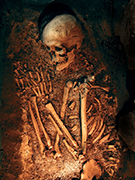
For a period of time on Earth, several different human species existed at the same time. Eventually, through evolutionary selection, we remained.
Several years ago, in a Siberian cave, scientists dug up fragments of a human cousin called the Denisovans (deh-NEESE-so-vans). We knew they were related to Neanderthals, but the fossil sample, a bit of her pinkie, was only enough for a rough DNA analysis.
That didn't deter a group of researchers who pioneered a technique which delivers an ancient genomic sequence that rivals the quality of a modern one. So, we now know the fossil is a little girl with brown eyes, hair, and skin who lived eighty thousand years ago.
Scientists extracted single stranded DNA and generated twenty times more readable DNA, giving them an extremely accurate view of the sequence, which wasn't possible before. The fossil confirmed Denisovans are a lesser-known sister species to Neanderthals.
She also shares DNA with modern humans, specifically Papua New Guineans, showing that early human species interbred. A comparison of the Denisovan fossil with modern human DNA sequences shows the two groups evolved in separate directions between one hundred seventy thousand and seven hundred thousand years ago.
Since that split, our DNA shows over one hundred-thousand DNA sequence changes. Eight in particular, involving brain wiring, may explain why we survived and the Denisovans didn't.
With the new technology acting as a sort of 'molecular time machine', scientists can now analyze many ancient fossils to add to our evolutionary tale.
More Information
A High-Coverage Genome Sequence from an Archaic Denisovan Individual
[Science. 2012 Oct 12;338(6104):222-6. doi: 10.1126/science.1224344. Epub 2012 Aug 30.]
This is the original journal article describing the methods and analysis of the Denisovan genome. This work was done by a large group of scientists from Germany and the United States.
A Crystal-Clear View of an Extinct Girl's Genome
[Science. 2012 Aug 31;337(6098):1028-9. doi: 10.1126/science.337.6098.1028.]
This is an excellent overview of the work described in the original paper by Ann Gibbons at Science magazine.